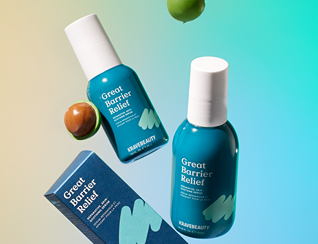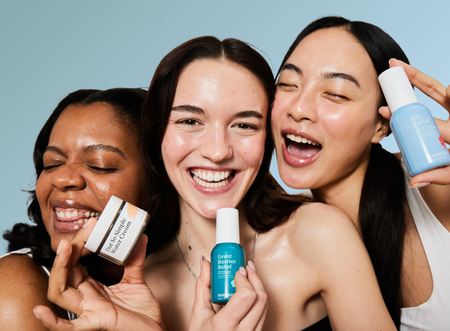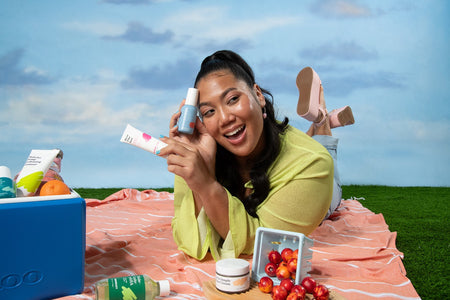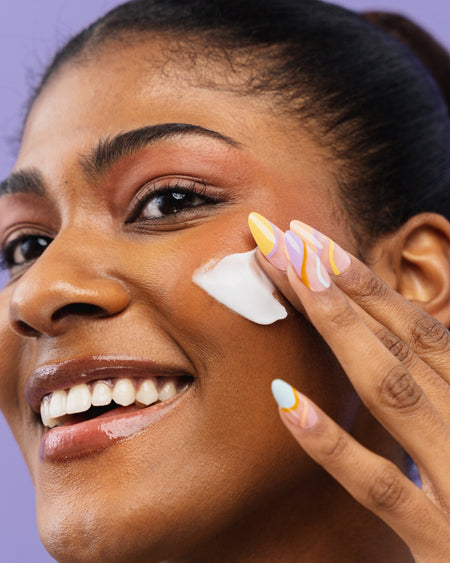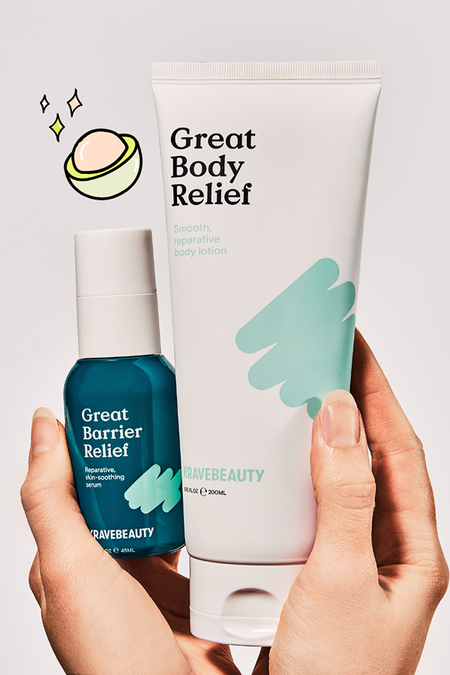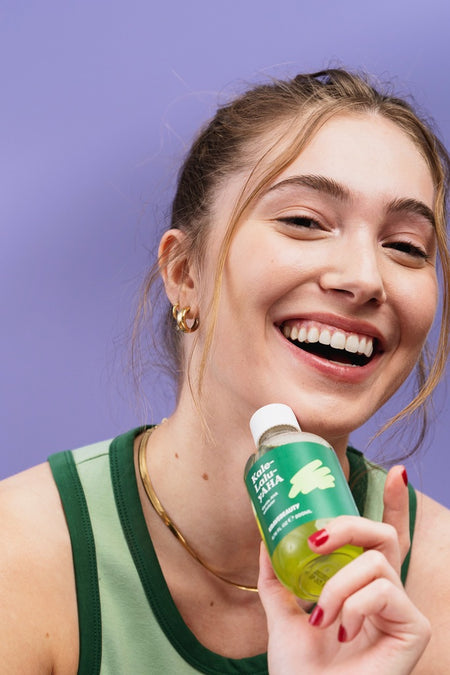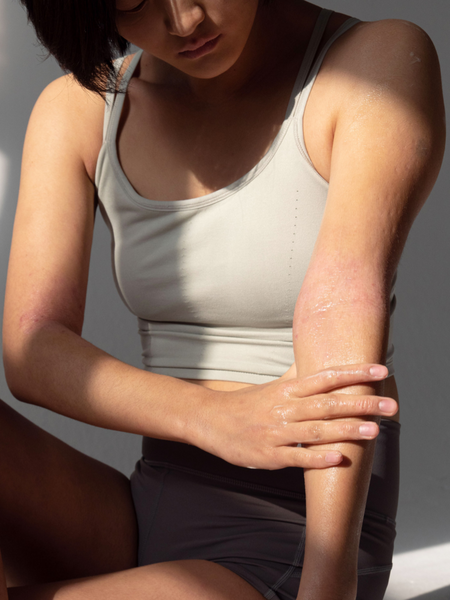Supplementary Skincare for Your Skin Concern

Hi there, friend! If you're coming from our #PressResetChallenge booklet, then welcome! We're so glad to have you here. If not, and you happen to have just stumbled upon this blog post, then hey, FYI we're hosting a 30-day challenge starting January 1st that helps you get in tune with your skin's true cravings and empowers you to practice seriously conscious, intuitive, and intentional skincare. Follow along on our Instagram (;
Here's a quick recap on how the #PressResetChallenge works: every day, participants log how their skin is feeling. For the first half, you'll strip your skincare down to the core basics (cleanser, moisturizer, sunscreen) and track how your skin is feeling daily with this simplified routine - letting your skin barrier heal during the process. Then once you hit day 16, you'll reassess by identifying your skin's cravings, doing your research, and incorporating supplements into your routine as needed (needed being the keyword here).
To help you get started on your research to figuring out which supplements would be best to address your skin concerns, we've organized some options for you below. But before we get into all of it: let's talk about skin types, or even better, let's stop talking about skin types.
Skin types are so last decade, don't you agree? You know, the old strict definitions of what your skin is supposed to be labeled as, like "oily, dry, sensitive", etc.? Let's ditch those in 2020 for good. Your skin is so smart, unique, and dynamic, and one or two words don't define it, so don't put it in that box. The goal should be to get your skin to its healthiest state where it is regulating itself to a more "normal" condition. Also, your skin is constantly changing, so go by how your skin is feeling at any given moment to address your concern instead of tailoring your routine to what your "type" is.
So...
If your skin feels dry aka rough, itchy, flaky, look for:
- Serums/moisturizers that contain Humectants, which work like magnets by drawing in water from the environment as well as from deep within your skin. The function of humectants is to grab onto surrounding moisture and pull it into your face, so it's important to know that if the surrounding air has less moisture than there is within your face, the humectant will be grabbing water from your face rather than the air (which isn't good!). So if your skin is dry, it's best to use humectants when you're in a space with higher humidity levels. For example, when stepping out of the shower into a humid bathroom or when next to a humidifier, etc.
- Some common humectants to look for are Glycerin, Sodium Hyaluronate, Hyaluronic Acid, Propylene Glycol, and Butylene Glycol, Sodium PCA, Sorbitol, Allantoin, Honey, Aloe Vera, Seaweed, and Algae
- Chemical exfoliants like AHA and/or BHA to help your dead, dry skin cells detach from your skin’s outer layer and keep your skin looking soft and supple by allowing it to hold onto more moisture. These are the best AHAs for dry skin:
- Glycolic Acid - due to its small molecule size, Glycolic Acid penetrates the skin deep and faster than most others. However, the concentration matters, especially to beginners. Kale-Lalu-yAHA is a great place to start!
- Mandelic Acid - derived from almonds, this AHA has the largest molecule size, which means it is not as fast-acting as some other AHAs you will find. But this ingredient has an extra superpower - it can stimulate the skin to produce more oil as well as strengthens the pore from the inside, making it strong and resilient with time!
- Thick creams, oils, or overnight masks with coconut oil (which is rich in medium-chain amino acids) if you have extra dry skin. It will help your skin retain moisture and keep it super smooth. Yes, please.
Some causes of dry skin include:
- Dry air, cold weather, over-cleansing, over-exfoliating, using harsh ingredients, aging, and lack of oil or water content in your skin.
If your skin feels oily aka it looks shiny or greasy, your makeup slides off throughout the day, your pores are enlarged, you get pimples in the oiliest areas of your face, look for:
- Oils! Don't get sucked into the idea that you shouldn't use oil just because you have oily skin. It's quite the opposite! Those with oily skin concerns tend to be deficient in linoleic acid, which is an essential fatty acid. Sebum deficient in linoleic acid is stickier and more likely to clog pores, so if you choose the right oil that is high in linoleic acid, it can help rebalance your skin. Oils that are high in linoleic acid are:
- Rosehip Oil, which is full of fatty acids, vitamins, and antioxidants.
- Squalane which has excellent anti-inflammatory properties and can help bring down skin swelling, and redness. FYI Squalane is one of the main ingredients in Oat So Simple Water Cream.
- Hemp Seed Oil won't clog your pores and is great for oily skin because of its ability to regulate your skin's oil production.
- Niacinamide, aka a great ingredient for regulating sebum production. Niacinamide has been shown to reduce surface sebum, but also boost your ceramide production which keeps your skin naturally more hydrated and moisturized, so you don’t get that parched but oily feeling.
- Products that contain the many forms of Zinc (like zinc PCA, zinc sulfate, and zinc oxide), since Zinc is known to be a sebum inhibitor. Zinc can be found in many products (e.g., serums, moisturizers), but it can also be very easily found as a critical ingredient in many physical sunscreens! Who would say no to some oil-controlling sun protection? ;)
Some causes of oily skin include:
- Genetics, humid and hot weather, hormonal changes (e.g., puberty, just before menstruation, pregnancy)
If your skin feels dull/congested, aka it looks dull, your pores are clogged, you have whiteheads, your skin texture feels rough and bumpy, look for:
- AHAs - they speed up cell turnover and help with the process of dead skin cells detaching from your skin surface, revealing smoother, younger skin underneath
- Glycolic acid - fastest acting of all due to a small molecule size, which helps clear blackheads by being able to penetrate deeper into the pores.
- Lactic acid has a larger molecule size, so although it can't exfoliate as deeply as glycolic acid, it's great as a surface treatment to help polish and firm your skin. It's also a lot more gentle for beginners.
- White Willow Bark Extract - a form of BHA, willow bark extract (which is found in many toners) has anti-inflammatory and redness-reduction benefits due to salicin, which is a type of salicylate.
- Vitamin C, which is a powerful antioxidant, helps protect against free radicals and environmental stressors that can cause dullness + strengthens the potency of your skincare when layered under for extra protection.
- Resveratrol - this skin-calming and redness-reducing antioxidant is great at protecting your skin's surface while brightening your overall complexion (btw this ingredient is also found in our The Beet Shield!)
Some causes of congested skin include:
- A buildup of dead skin cells (poor turnover), humid and polluted environments, and an unhealthy diet.
If your skin feels dehydrated, aka looks dull, feels oily but tight, look for:
- Humectant-rich and skin barrier repairing ingredients, like Glycerin, Sodium PCA, Ceramides, and Cholesterol. These ingredients can help bring hydration back into your skin since your dehydrated skin may indicate a comprised moisture barrier, in which one can experience an easy escape of hydration in your skin (aka TEWL).
- Great Barrier Relief is an awesome skin-soothing serum that helps repair and restore your skin barrier! It's great for anyone who needs to #PressReset on irritated skin. FYI it may not be the best for those with fungal acne or some people prone to acne.
Some causes of dehydrated skin include:
- Not drinking enough water, an impaired barrier that can’t lock in moisture, air quality, and excess alcohol consumption.
If your skin feels irritated and/or sensitive or if you have eczema/rosacea; where your skin is dry, you get sunburnt easily, you get rashes often, experience excessive redness, look for:
- Barrier-friendly ingredients, such as fatty acids, cholesterol, and natural moisturizing factors, since your skin barrier may be compromised.
- Products with Niacinamide! It helps renew, restore, and prevents moisture loss by increasing your skin's natural production of ceramides.
- Calming ingredients like Aloe Vera and Allantoin to help soothe and soften skin without irritation.
- Oat extract, which has tremendous skin-calming properties!
Hot tip: Make sure you're adding any supplements into your routine very slowly, as not to irritate your skin even further.
Some causes of irritated/sensitive skin include:
- Excessive exposure to damaging environmental factors like wind, sun, heat or cold, and allergies, genetic/medical conditions
If you notice new breakouts, aka you see new whiteheads, red cysts, painful bumps, etc., look for:
- Sulfur, which you can find in many purifying masks., helps with breakouts through its antibacterial properties and by absorbing excess oil
- Salicylic Acid (BHA) - deeply penetrates the skin and has anti-inflammatory properties to help reduce pimples quickly, and unclog pores.
- Mandelic Acid - since acne damages pores, mandelic acid is a great exfoliator because it helps to exfoliate them and makes them stronger from within. Also, it brightens the skin and dissolves skin cells to help with hyperpigmentation and acne.
- Glycolic Acid, which helps to get rid of oil and dead skin buildup that can cause acne, It also lightens and reduces acne spots and hyperpigmentation
- Vitamin A, which smooths and evens skin tone, helps decrease oil production and increases skin growth to heal scars.
Some causes of breakouts include:
- Hormones, excess oil production, and underlying bodily inflammation (stemming from an unhealthy diet, stress, lack of sleep, etc) .
If you have fungal acne, aka notice small white spots, look for:
- Antifungal medication like:
- Ketoconazole 2%, which is usually found in anti-dandruff shampoo (such as Nizoral, Ketoconazole 1%),. Yup, you read that right.
- You can use it by applying the shampoo on your damp face, and use it like you would a wash-off mask. Leave it on for around 5 minutes before rinsing it off. You can use it every night or once every two nights for 2-4 weeks to see the change in your skin.
- Zinc Pyrithione 1% or Selenium Sulphide 2.5%, which is also found in anti-dandruff shampoo (usually Head & Shoulders).
- Use the same process as above ^
- Products with Sulfur, Sulfur wash, mask, or spot treatment.
(BTW, we specifically formulated Oat So Simple Water Cream to be safe for those with fungal acne-prone skin!)
If you notice more fine lines, wrinkles, look for:
- Vitamin C - free radicals are heavily responsible for signs of aging, and this powerful antioxidant helps to fight them off!
- Peptides - basically tells your skin to produce more collagen, which is awesome because collagen keeps your skin healthy, youthful, and firm. And by being able to penetrate the top layer of your skin, they also help with fine lines and wrinkles.
- Copper - not only does Copper combat inflammation, but it also helps firm your skin, and helps reduce the appearance of wrinkles, photo-damage, and hyperpigmentation.
- Retinoids/Retinols - the most powerful tool in your arsenal. It speeds up cell turnover and increases collagen production, plumping your skin from within. (If you decide to start on a retinol/noid journey though, be sure to do your research, start slow, and include no other supplementary skincare besides the retinol/noid.)
Some causes of fine lines and wrinkles include:
- Sun exposure, smoking, genetics, aging
Remember to always listen to your skin, and cater your skincare routine to how your skin is adapting to the environment around you. Not everything will work for everyone. Find the ingredients and products that work best for you and change them up if that's what you're feeling.
If you're interested in joining our #PressResetChallenge, we'd love to have you, and you can follow along on our Instagram. We can't wait to see how your skin feels at the end of the journey.

